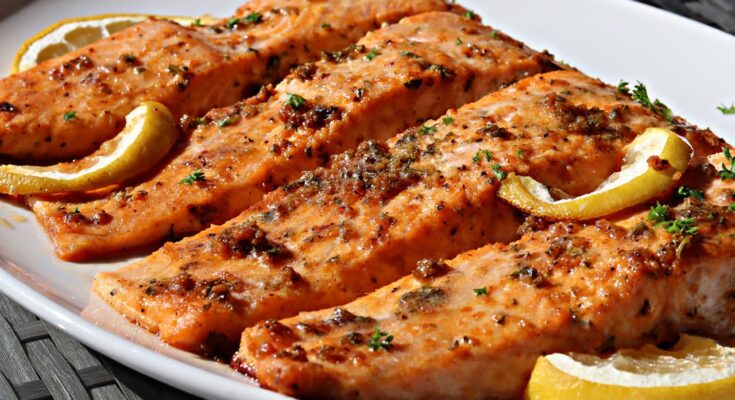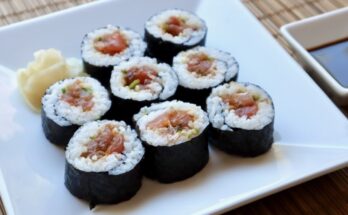Baked Salmon Recipe: Salmon is more than just a tasty fish—it’s a powerhouse of nutrients that should make regular appearances on your dinner table. Baked salmon is one of the easiest and most satisfying ways to enjoy this popular fish.
In this guide, I’ll walk you through every step of baking salmon, from picking the best fish to knowing exactly when it’s perfectly cooked.
Why Bake Salmon?
Baking is one of the healthiest ways to cook salmon. It requires very little oil and retains most of the fish’s natural oils and nutrients. Baking also ensures the salmon stays tender and moist, with minimal effort on your part. Plus, baked salmon has a clean flavor that can be enhanced with just a few simple seasonings.
Ingredients for Baked Salmon
You don’t need a lot of ingredients to make delicious baked salmon. Here’s a list of what you’ll need:
Basic Ingredients:
- 4 salmon fillets (about 6 oz each)
- 2 tablespoons olive oil
- 1 lemon (sliced)
- 3 garlic cloves (minced)
- Salt and pepper to taste
- Fresh herbs (like dill, parsley, or thyme)
Optional Ingredients for Extra Flavor:
- Soy sauce or teriyaki glaze
- Honey or maple syrup for a sweet twist
- Red pepper flakes for a kick
- Dijon mustard for tanginess
Choosing the Right Salmon
When choosing salmon, you’ll often have two main options: wild-caught or farm-raised. Wild-caught salmon generally has a stronger flavor and firmer texture, while farm-raised is milder and often fattier. Both are delicious when baked, but wild-caught is usually preferred for its nutritional value and sustainability.
If you’re using frozen salmon, let it thaw completely before cooking for the best texture and flavor. Fresh salmon should have a vibrant color and no fishy smell.
How to Prepare Salmon for Baking
Before you bake your salmon, it’s important to properly prep the fish:
- Rinse the Salmon: Gently rinse your salmon fillets under cold water to remove any surface residue.
- Remove Bones: Feel along the fillet with your fingers to check for pin bones and use tweezers to carefully remove them.
- Pat Dry: Use a paper towel to dry the fillets, which will help the seasonings stick better and the fish cook more evenly.
Step-by-Step Instructions for Baking Salmon
Now, let’s get down to the cooking. Follow these steps to make perfectly baked salmon:
- Preheat Your Oven: Set your oven to 400°F (200°C).
- Prepare the Baking Tray: Line a baking sheet with aluminum foil or parchment paper for easy cleanup.
- Season the Salmon: Place the salmon fillets on the baking tray and drizzle them with olive oil. Sprinkle salt, pepper, and minced garlic on top. Lay lemon slices on each fillet for a bright, zesty flavor.
- Wrap the Salmon (Optional): If you want to retain more moisture, wrap each fillet in foil or parchment paper to create a little steam pocket.
How to Bake Salmon in Foil
Foil-baking is one of the best ways to keep your salmon moist and flavorful. Here’s how to do it:
- Create a Foil Packet: Place the seasoned salmon in the center of a large piece of foil. Fold the edges up and around the fillet to create a sealed packet.
- Bake: Place the foil packets on the baking sheet and bake for about 12-15 minutes, depending on the thickness of the fillet.
- Check for Doneness: Open one of the packets and use a fork to see if the fish flakes easily. If it does, it’s ready to serve.
Baked Salmon Without Foil
Prefer your salmon with a bit of a crispy edge? Baking without foil is just as easy:
- Lay the Fillets Directly on the Baking Sheet: Season your salmon and place it skin-side down on the lined baking tray.
- Bake Uncovered: Put the tray in the oven and bake for 12-15 minutes, or until the fish reaches the desired doneness.
Cooking Times and Temperatures for Baked Salmon
The general rule of thumb is to bake salmon at 400°F (200°C) for 12-15 minutes per inch of thickness. If you have a thicker cut of salmon, you may need to add a few minutes. Always aim for an internal temperature of 145°F (63°C) at the thickest part of the fillet.
How to Know When Your Salmon is Done
Salmon is done when it flakes easily with a fork and has an opaque, slightly pink color in the center. If you’re unsure, use a meat thermometer to check the internal temperature. For perfectly cooked salmon, it should register at 145°F (63°C).
Best Seasoning for Baked Salmon
There’s no shortage of seasoning options for salmon, but here are a few of my favorites:
- Classic Lemon and Herb: Use fresh lemon slices and a sprinkle of herbs like dill, parsley, or thyme.
- Garlic Butter: Melted butter mixed with minced garlic and herbs adds a rich flavor to the fish.
- Spicy Kick: Try adding a dash of paprika, chili powder, or red pepper flakes for a bit of heat.
Tips for Moist and Flavorful Salmon
To keep your salmon moist and full of flavor:
- Avoid Overcooking: Keep an eye on the time and remove the salmon from the oven as soon as it’s done.
- Add Moisture: Brushing the fish with olive oil or a butter-based sauce can help lock in moisture.
- Use Citrus: The acidity from lemon juice adds brightness to the dish and prevents dryness.
Serving Suggestions for Baked Salmon
Salmon pairs well with a variety of sides. Some great options include:
- Steamed or roasted vegetables (like asparagus, broccoli, or carrots)
- A light salad with a lemon vinaigrette
- Quinoa or rice for a heartier meal
- Mashed potatoes or garlic bread
How to Store and Reheat Baked Salmon
If you have leftovers, store your baked salmon in an airtight container in the refrigerator for up to 3 days. To reheat, place the salmon in a 300°F (150°C) oven for about 10 minutes, or until warmed through. Be careful not to overheat it, as this can dry out the fish.
FAQs about Baked Salmon Recipe
1. How long should I bake salmon?
For perfectly baked salmon, preheat your oven to 375°F (190°C) and bake for about 12-15 minutes. The salmon should flake easily with a fork when fully cooked.
2. Should I cover salmon while baking?
Covering the salmon with foil helps retain moisture, making it tender and juicy. However, leaving it uncovered will give you a slightly crispier texture.
3. What temperature should salmon be cooked to?
The internal temperature of salmon should reach 145°F (63°C) for safe consumption. Use a food thermometer to check the thickest part.
4. Can I bake frozen salmon?
Yes! You can bake frozen salmon, just increase the baking time to about 20-25 minutes, ensuring the fish reaches a safe internal temperature.
5. What seasonings go best with baked salmon?
Common seasonings include garlic, lemon, dill, and olive oil, but feel free to experiment with your favorite spices and herbs for a flavorful twist!
Conclusion
In summary, this waffle recipe is easy to follow and guarantees fluffy, delicious waffles every time. Whether you’re making them for a special breakfast or a quick treat, waffles never disappoint.
Don’t hesitate to get creative with your toppings or even tweak the batter to suit your taste—whether that means adding a hint of vanilla, sprinkling in chocolate chips, or experimenting with whole wheat flour.
Enjoy the versatility of this classic recipe, and have fun trying different variations to make it your own!



